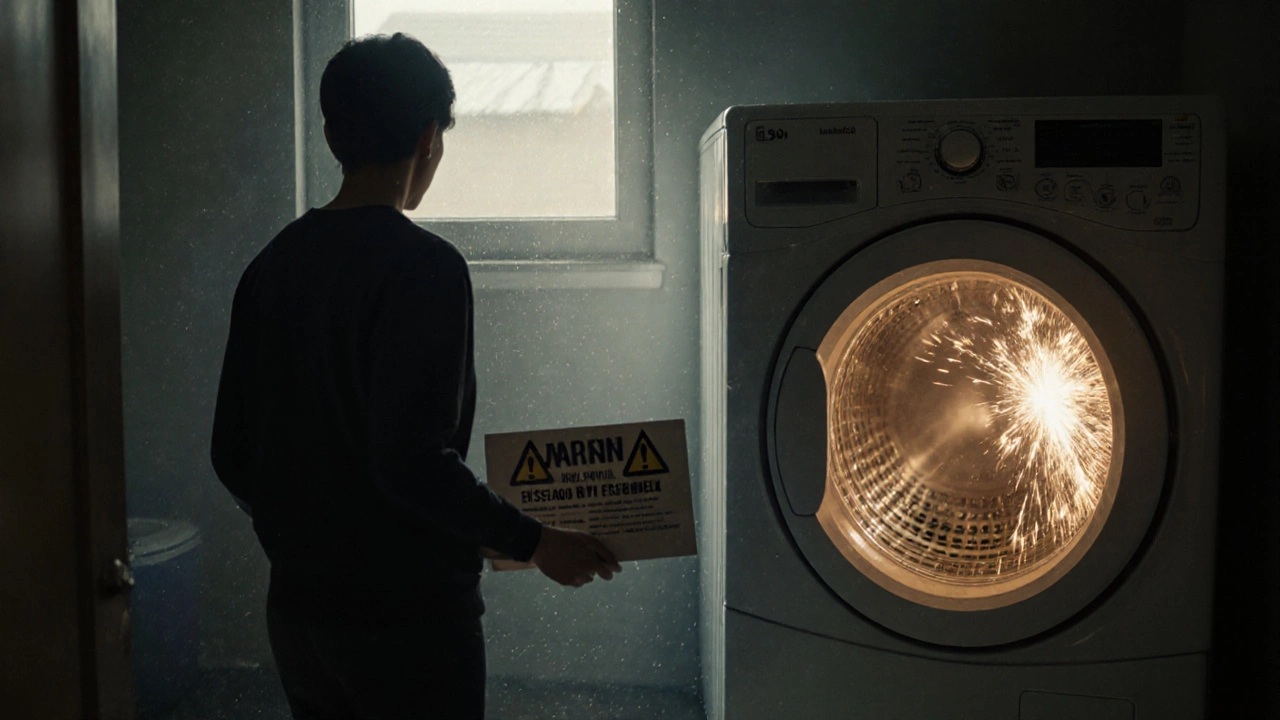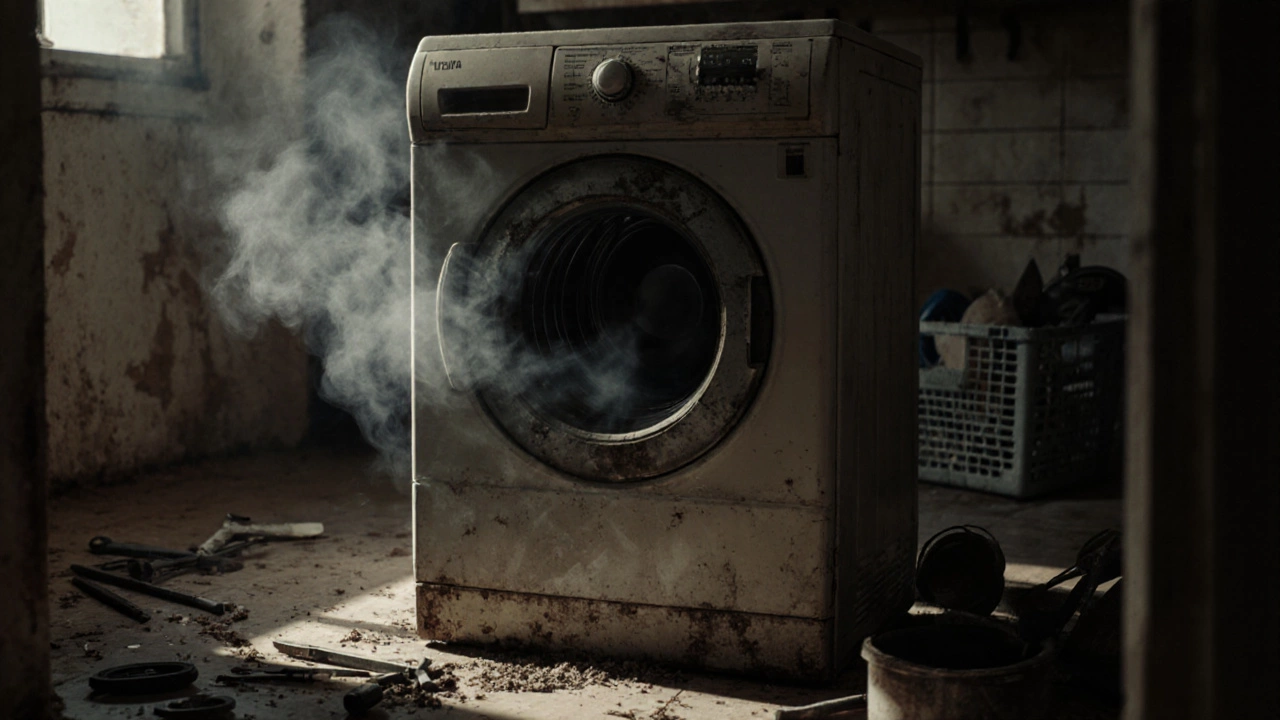Dryer Replacement Cost Estimator
Potential Annual Savings: $ (based on 30% energy efficiency gain)
You hear the loud grinding noise. The dryer won’t spin. Or maybe it’s been taking three cycles just to dry a load. You grab your toolbox and start thinking about fixing it. But before you spend hours and money on parts, ask yourself this: is this repair even worth it?
Age matters more than you think
Most dryers last between 10 and 13 years. If yours is 12 or older and you’re dealing with a major issue-like a broken drum, motor failure, or heating element that keeps burning out-it’s not a repair. It’s a temporary fix. Dryers this old don’t just wear out; they become unreliable. Parts are harder to find, and the energy efficiency has dropped by 30% or more compared to new models. A 15-year-old dryer might cost $100 to fix, but it’s using twice as much electricity as a new one. That adds up to $150-$200 extra per year in power bills. Paying $100 now to keep it running for another year? That’s not saving money. That’s throwing cash into a sinking ship.Repair costs more than half the price of a new one
Here’s a simple rule: if the repair quote is more than half the cost of a new dryer, walk away. A new mid-range electric dryer in New Zealand costs between $600 and $900. So if a technician says it’ll cost $350 or more to replace the drum bearings, motor, or control board, you’re better off buying new. This isn’t just about money-it’s about risk. Even after a $300 repair, you’re still stuck with an aging machine that could break again in six months. New dryers come with a full 12-month warranty. Repaired ones? You get 30 days, if you’re lucky.Multiple repairs in a short time
If you’ve fixed your dryer twice in the last year, it’s not coincidence. It’s a pattern. Maybe you replaced the thermal fuse last winter. Then the belt snapped in spring. Now the drum won’t turn. Each repair fixes one symptom, but the underlying wear is still there. Dryers are mechanical systems. When one part fails, others are close behind. Think of it like an old car: replacing the transmission doesn’t fix the rusted frame or the failing suspension. Same with dryers. Repeated repairs mean you’re paying for short-term fixes while the whole system is crumbling. Save yourself the stress and upgrade.It’s unsafe to run
Some problems aren’t just inconvenient-they’re dangerous. If your dryer is overheating, emitting a burning smell, or tripping the circuit breaker every time you use it, don’t try to fix it yourself. Overheating can be caused by a blocked vent, a faulty thermostat, or a damaged heating coil. But if the vent is clear and the thermostat checks out, the issue might be deeper-like a cracked heat exchanger or frayed wiring inside the cabinet. These aren’t DIY fixes. They’re fire hazards. In New Zealand, dryers cause around 200 house fires each year. Most of them are from old, poorly maintained machines. If your dryer is sparking, smoking, or smells like burning plastic, turn it off. Unplug it. Call a professional to confirm the danger. Then buy a new one.It’s not drying properly-even after cleaning
A dryer that takes forever to dry clothes isn’t just annoying. It’s wasting energy and damaging your fabrics. First, clean the lint filter. Then check the vent hose for kinks or blockages. If you’ve done both and it still takes two or three cycles, the problem isn’t airflow. It’s the heating system. A weak heating element or failing thermostat can’t get the drum hot enough. Replacing these parts costs $150-$250. But here’s the catch: if the dryer is older than 8 years, the heat control system is likely outdated. New dryers use moisture sensors that automatically stop the cycle when clothes are dry. Older models just run for a set time, even if clothes are still damp. That means you’re paying more for electricity and wearing out your clothes faster. A new sensor-equipped dryer can cut drying time by 40% and save you $50-$80 a year.The drum is cracked or bent
The drum is the heart of the dryer. If it’s cracked, warped, or no longer spins smoothly, the whole machine is compromised. A cracked drum can cause clothes to snag, tear, or get caught between the drum and the casing. This isn’t just a repair-it’s a safety issue. Replacing the drum costs $200-$350, depending on the model. But here’s the reality: drum replacements are rarely done on older models because manufacturers stop making them. Even if you find one, it won’t match the original specs. You’ll end up with a dryer that’s louder, less balanced, and more prone to vibration damage. A new dryer has a solid, seamless drum designed to last 10+ years. Why settle for a patched-together replacement?
You’re tired of the noise
Dryers aren’t silent. But if yours sounds like a jackhammer-clunking, rattling, or screeching-it’s not normal. Worn drum rollers, a bad idler pulley, or a failing motor can all cause loud noises. You might think, “It’s just noisy, it still works.” But noise is a symptom. It means parts are grinding against each other. That friction wears down other components faster. And the vibration? It can loosen screws, crack the cabinet, or damage the floor beneath it. If you’re constantly walking past the laundry room with your hands over your ears, it’s time to go. Modern dryers are designed with noise reduction in mind. Many new models run at 60 decibels or less-about the sound of a normal conversation. You’ll notice the difference immediately.It’s not compatible with your lifestyle
New dryers aren’t just better-they’re smarter. If you have a large family, a front-load dryer with a 9kg capacity will save you time and effort. If you care about energy use, a heat pump dryer cuts power consumption by up to 60% compared to traditional vented models. If you’re away from home often, a dryer with Wi-Fi and app control lets you start or stop cycles remotely. An old dryer doesn’t offer any of that. You’re stuck with basic settings, long cycles, and no alerts when the lint trap is full. If your life has changed-more kids, working from home, tighter bills-your dryer should keep up. Holding onto an outdated machine doesn’t save money. It costs you time, comfort, and control.What to do instead
If you’ve ruled out repair, here’s what to do next:- Check for government rebates. New Zealand’s Warm Up New Zealand scheme sometimes offers discounts on energy-efficient dryers.
- Compare front-load vs. top-load. Front-load models are gentler on clothes and use less water if paired with a washer.
- Consider a heat pump dryer. They cost more upfront ($1,200-$1,800), but save $150-$250 a year on electricity.
- Recycle your old dryer. Most councils offer free pickup or drop-off for appliance recycling.
Replacing a dryer isn’t a failure. It’s a smart upgrade. You’ll get faster drying, lower bills, quieter operation, and peace of mind. And if you’re still unsure, ask yourself this: if you were buying a new dryer today, would you pick the same one you’ve got? If the answer is no, it’s already decided.
Is it worth repairing a 10-year-old dryer?
Generally, no. A 10-year-old dryer is near the end of its lifespan. Even if the repair works, you’re likely to face another issue within a year. The cost of parts and labor often exceeds 50% of a new dryer’s price. Plus, newer models are significantly more energy-efficient, which saves money over time.
How much should a dryer repair cost before I replace it?
If the repair quote is more than half the price of a new dryer, skip it. For example, if a new dryer costs $700, don’t spend more than $350 on repairs. Anything above that means you’re paying more for a temporary fix than you would for a reliable, warrantied replacement.
Can a cracked dryer drum be repaired?
No. A cracked drum cannot be safely or effectively repaired. Welding or patching it won’t hold under heat and spinning stress. Replacement drums are expensive and often unavailable for older models. Replacing the entire dryer is the only safe and practical solution.
Why does my dryer take so long to dry clothes?
If the lint filter and vent are clean, the issue is likely a weak heating element or failing thermostat. Older dryers lack moisture sensors, so they run on timers instead of actual dryness. This means they often run longer than needed. New dryers with sensors stop automatically when clothes are dry, cutting drying time by up to 40%.
Are heat pump dryers worth the extra cost?
Yes, if you use your dryer often. Heat pump dryers use 50-60% less electricity than traditional vented models. While they cost $1,200-$1,800 upfront, they save $150-$250 per year on power bills. In a household that runs the dryer 4-5 times a week, the payback period is 4-6 years. After that, you’re saving money every month.
What should I do with my old dryer?
Don’t leave it on the curb. Most New Zealand councils offer free appliance recycling programs. Some retailers also take old dryers when you buy a new one. Recycling ensures harmful materials like refrigerants and copper wiring are handled safely, and metal parts are reused.

